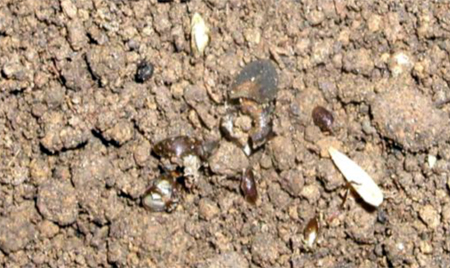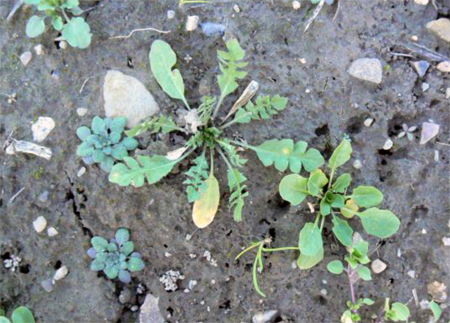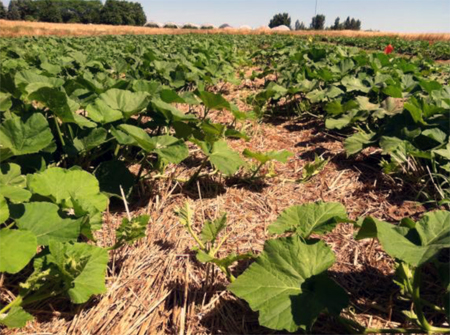Fall-tillage tips for vegetables
Undecided about whether to till your vegetable fields this fall, or even when to do it or why?
Decisions about how and whether to till vegetable fields in the fall are complex and depend on balancing soil, nutrient, pest and economic considerations. Fall tillage is helpful for managing many pests of vegetables and for incorporating soil amendments, but can also lead to soil degradation, nutrient losses and unnecessary expenditures in some cases. Below are a few key principles to keep in mind when making decisions about fall tillage.
Avoid tillage when fields are wet
Tillage when soil is wet (above field capacity) can lead to soil compaction, soil smearing and clod formation, all of which ultimately reduce crop yields. Since soil moisture in late summer and fall is often lower than in the spring, fall-tillage can reduce the risk of these potential problems. On the other hand, if fields are wet in the fall, it may be better to wait until spring in the hopes that moisture conditions will be more suitable. Delaying tillage until spring is less risky on fields with light, well-drained soils and on those where late-planted vegetables are planned.
Time tillage to suppress insects and diseases
Many vegetable insects, such as squash vine borer, and pathogens, such as black rot, survive in crop residue. Therefore, fall-tillage can reduce the risk of recurrence of these pests by burying residue in the soil where microorganisms speed decomposition. However, for insects and diseases that do not depend on crop residue for survival, like migratory pests and some soil-borne diseases, fall-tillage often provides little benefit and may even increase survival by burying pests and their propagules (larvae, spores) to depths where they are less vulnerable to decay or where they are induced into a dormant state. Under these conditions, subsequent tillage may bring them back to the surface to infest future crops. Clearly, knowing the rotational and pest history of a field, as well as the life-cycle of key pests, is valuable for making optimal tillage decisions.
Time tillage to suppress weeds
Tillage can impact weeds by uprooting or burying seedlings, changing the depth of weed propagules (i.e., seeds) in the soil, and by stimulating seed germination. If you’ve just harvested a vegetable field and perennial (i.e., horsenettle) or winter annual seedlings (i.e., chickweed) are taking hold, fall-tillage may be an important weed management strategy. Likewise, if immature summer annual weeds (i.e., lambsquarters or pigweed) are present that are likely to produce seeds before a killing frost, tillage is one option for preventing seed production.
On the other hand, if your field is loaded with weeds that have already shed thousands of seeds on the soil surface, delaying tillage until late fall or spring may be beneficial; seeds left on the soil surface are more vulnerable to consumption by seed predators or decay organisms than those buried through tillage (Photo 1).

Photo 1. Remains of weed seeds eaten by seed predators. When fall tillage is
delayed or avoided, predators,including carabid beetles, will consume seeds
of many weed species. Seeds that are buried through tillage are protected from
predation and may survive for decades.
Also keep in mind that for many weed species, tillage can result in a flush of weeds by exposing seeds to germination cues including light and soil nitrates. Winter annual weeds – including many in the mustard family – are particularly sensitive to these cues in the early fall. Therefore, delaying tillage until late fall or early spring is one strategy for reducing potential problems with these weeds (Photo 2).

Photo 2. Fall tillage can stimulate germination of winter annual weeds, including
field pennycress and sheperd's-purse (two largest weeds shown in photo), both
of which may host insects and diseases of mustard family crops.
Time tillage to manage manure and minimize nutrient and soil loss
Incorporation of manures within 12 hours of application is generally recommended to avoid loss of N as ammonia. Since manure applications must be made 90 to 120 days before crop harvest, manure application and associated tillage is most safely accomplished in the fall. This is particularly true for vegetables that are in contact with soil and are destined for fresh consumption. However, keep in mind that tillage in the fall exposes soil to erosion and can result in significant nutrient and soil losses.
Where fall-tillage is used for manure incorporation or disease management, planting a cover crop immediately following tillage, like winter rye, can reduce nutrient losses and protect the soil. Manure application and incorporation technologies that leave at least some crop residue in place, such as injection systems and vertical tillage, are also useful for minimizing soil loss.
Implement conservation tillage where possible
Although strict no-till production is challenging in vegetable crops, many opportunities exist for reducing the number of tillage passes or the amount of soil disturbance with each pass. Less tillage can result in lower costs, improved soil characteristics and, ultimately, higher yields. Conservation tillage practices range from relatively simple approaches, like using less aggressive tillage tools (i.e., chisel plow or spade instead of a moldboard plow or rototiller) or planting fall cover crops with a no-till drill, to more experimental approaches like “zone tillage,” where tillage is targeted only to the area of the field where it is needed most. For example, strip-tillage systems commonly used in field crops can be successfully adapted to vegetable productions systems (see Photos 3 and 4).

Photo 3. Butternut squash grown under strip tillage. In strip-tilled production, a
winter rye cover crop was planted in the fall following light disking of last year's
bean crop; squash was planted into 9-inch wide by 12-inch deep strips that were
tilled in the spring. Note that soil splash on leaves in conventional tillage (see photo
below) is avoided where strip tillage was used.

Photo 4. Butternut squash grown under conventional spring tillage. In strip-tilled
production, a winter rye cover crop was planted in the fall following light disking
of last year's bean crop; squash was planted into 9-inch wide by 12-inch deep strips
that were tilled in the spring. Note that soil splash on leaves in conventional tillage
is avoided where strip tillage was used.
In sum, decisions about whether, when and how to till should be guided by the knowledge of how tillage impacts specific soils and pests. When specific benefits of fall tillage are not obvious, consider saving time and money and improving your soils by delaying, reducing or eliminating tillage.
Dr. Brainard's work is funded in part by MSU's AgBioResearch.



 Print
Print Email
Email

